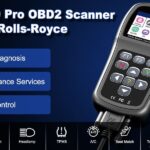For those who are hands-on with their vehicles, especially Cummins diesel trucks, the ability to perform diagnostics at home is invaluable. On-Board Diagnostics (OBD2) systems have become standard in modern vehicles, offering a wealth of data and diagnostic capabilities. The question many Cummins owners ask is whether free OBD2 software can adequately meet their diagnostic needs, or if investing in more comprehensive, often paid, software is necessary.
The appeal of free Cummins OBD2 software is undeniable. For basic tasks like reading and clearing generic fault codes, several free apps and entry-level scan tools are available. These tools can be helpful for quickly identifying common issues indicated by the check engine light. They often provide basic sensor data and can be sufficient for very simple troubleshooting. However, the capabilities of free software are typically limited when it comes to the more intricate systems within a Cummins engine and its associated components.
Cummins diesel engines, particularly those in heavy-duty trucks, are complex machines with sophisticated electronic control systems. Diagnosing issues beyond basic fault codes often requires software that can delve deeper into the engine control module (ECM), transmission control module (TCM), and other vehicle systems. This is where the limitations of free OBD2 software become apparent. Features such as advanced parameter monitoring, live data streaming at high speeds, bidirectional controls, and specialized diagnostic tests are generally absent in free versions.
For instance, tasks like performing a quick learn procedure on a 68RFE transmission, as mentioned by experienced users, or conducting cylinder cutout tests, injector testing, and variable geometry turbocharger (VGT) calibration, demand software with advanced functionalities. These are the types of diagnostic and maintenance procedures that can optimize engine performance, ensure longevity, and accurately pinpoint complex problems. Free OBD2 software typically lacks the depth and breadth of functions to execute these Cummins-specific procedures effectively.
Furthermore, professional-grade software often provides access to proprietary diagnostic trouble codes (DTCs) and detailed repair information that are not available through generic OBD2 protocols. This enhanced level of access can significantly reduce diagnostic time and improve the accuracy of repairs, particularly when dealing with intricate Cummins engine issues. While the initial cost of professional software may be a barrier for some, the time saved, the potential for more accurate diagnoses, and the expanded capabilities often justify the investment for serious DIYers and professional mechanics alike.
In conclusion, while free Cummins OBD2 software can serve as a starting point for basic diagnostics and fault code reading, it often falls short when addressing the complexities of Cummins diesel engines and their advanced systems. For comprehensive diagnostics, specialized tests, and in-depth system analysis, investing in professional-grade OBD2 software is generally recommended. This ensures access to the necessary tools and information to maintain and repair Cummins vehicles effectively.
